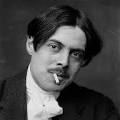Vorticism / Paul Nash
Vorticism
The group was founded by the artist, writer, Wyndham Lewis in 1914. Their only group exhibition was held in London the following year. Vorticism was launched with the issue (of two) of the magazine Blast which contained among other material two aggressive manifestos by Lewis ‘blasting’ what he considered to be the effeteness of British art and culture and proclaiming the vorticist aesthetic: ‘The New Vortex plunges to the heart of the Present – we produce a New Living Abstraction’.

Vorticist painting combined cubist fragmentation of reality with hard-edged imagery. It was, in effect, a British equivalent to futurism, although Lewis was deeply hostile to the futurists. The First World War brought vorticism to an end, although in 1920 Lewis made a brief attempt to revive it with Group X. The horrors of war brought about a rejection of the avant-garde in favour of traditional art making, known as return to order.
Although most of us had not come across the Vorticist movement, overall we were not very impressed with their work! In 1956 Wyndham Lewis stated that “ Vorticism was, in fact, what I, personally, did and said at a certain period” The movement was often seen as a predominantly masculine affair but at least two women were part of the movement including Jessica Dismorr who was born in Gravesend

Paul Nash (11 May 1889 – 11 July 1946) was a British surrealist painter and war artist, as well as a photographer, writer and designer of applied art. Nash was among the most important landscape artists of the first half of the twentieth century. He played a key role in the development of Modernism in English art.
The artworks he produced during World War I are among the most iconic images of the conflict. After the war Nash continued to focus on landscape painting, originally in a formalised, decorative style but, throughout the 1930s, in an increasingly abstract and surreal manner. In his paintings he often placed everyday objects into a landscape to give them a new identity and symbolism.
During World War II, although sick with the asthmatic condition that would kill him, he produced two series of depictions of aircraft, before producing a number of landscapes rich in symbolism with an intense mystical quality. Nash was also a fine book illustrator, and also designed stage scenery, fabrics and posters.
We thoroughly enjoyed exploring Nash’s work. We were astonished at the extraordinary variety. We also were impressed by his poetical letters.

